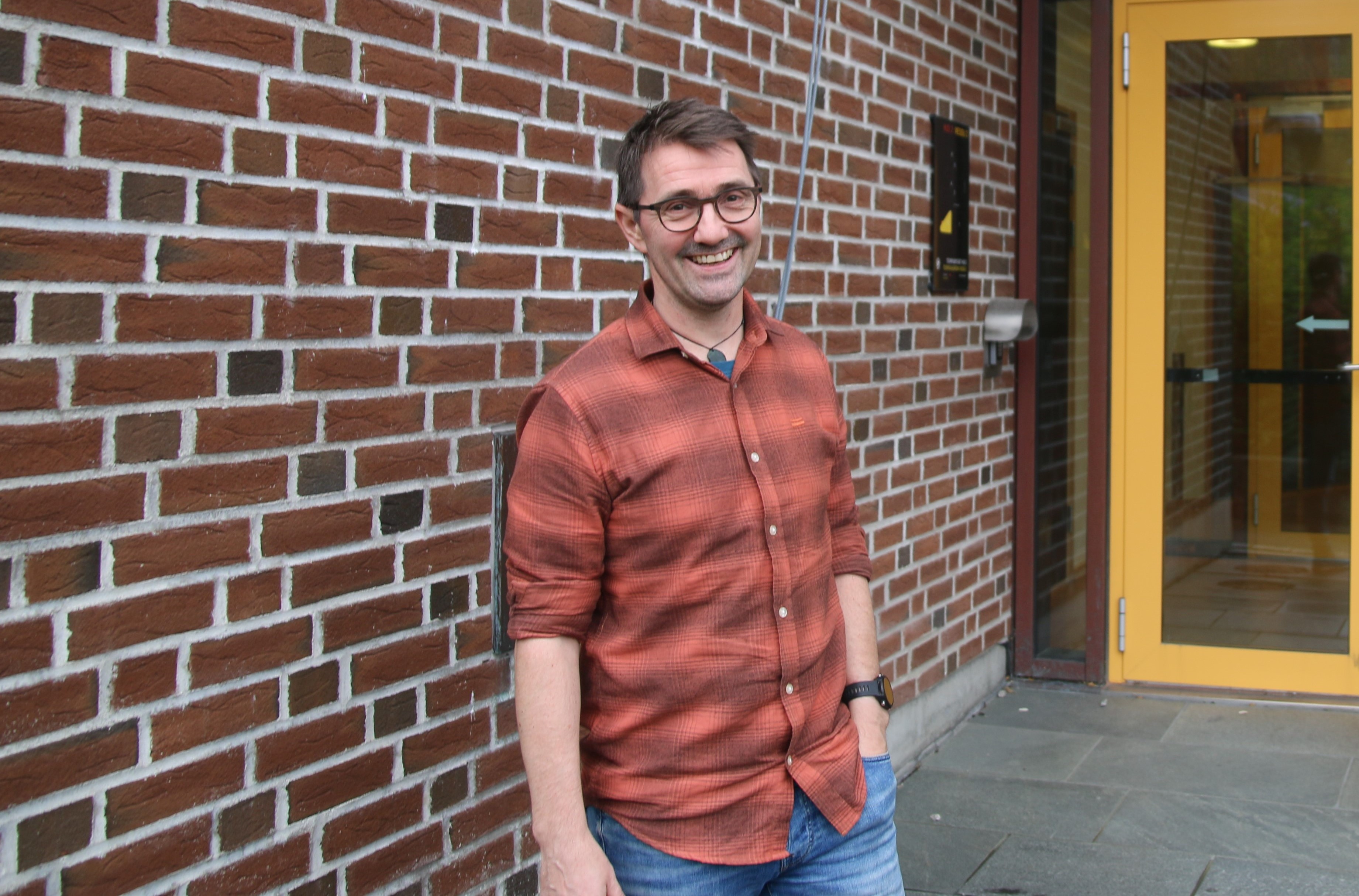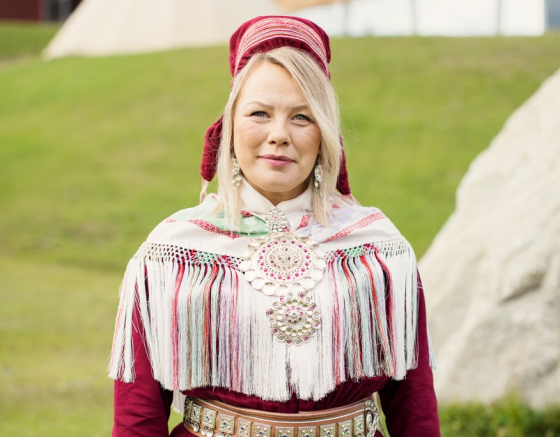“Without our university, there wouldn’t have been any Sámi-speaking teachers”
Sámi University of Applied Sciences is the main supplier of Sámi-speaking teachers to schools in Finland, Norway, Sweden and Russia. The majority are women, but an increasing number of men are also applying, according to Rector Laila Susanne Vars.
Students of Sámi origin have a number of higher education programmes and courses they can take that are taught in the Sámi language. UiT The Arctic University of Norway has its own quotas for students who speak Sámi, and study programmes at Sámi University of Applied Sciences are mainly taught in the Sámi language.
There are some challenges, however. There is a pressing need for more teachers, health workers and lawyers who speak Sámi, and these are in short supply in several municipalities in the northernmost counties of Norway. Furthermore, there appear to be notable gender differences in terms of which persons of Sámi origin take higher education.
Who are the Sámi students?
Torjer Olsen is head of the Centre for Sámi Studies at UiT, and has observed these challenges for several years. He emphasises that there is a limit to what we can statistically proclaim about Sámi students, but that it is possible to make assumptions based on the larger trends in society.
The level of higher education is generally lower in the northernmost counties. Olsen attributes this to the differences between study trends in urban and rural areas, which we also find elsewhere in the country.
"We need to know more," he says.
"Categorisation on the basis of ethnicity is not permitted in surveys and evaluations conducted at universities. It’s therefore more a matter of guesswork. You can base assumptions on the population trend in the northern part of the country. This is not certain, but there may be some correspondence with figures from the majority population in the northernmost counties when, for example, we look at who takes an education and why.”
There are no unambiguous figures on the number of Sámi people in Norway. It is estimated that there are between fifty thousand and one hundred thousand. As a result of the Norwegianisation policy, some no longer wish to define themselves as Sámi, while acceptance in more recent times has meant that others have chosen to reclaim the culture.
According to Olsen, one factor that can be used as a basis for estimates is the number of students with Sámi language skills. UiT’s graduates survey from 2021, for example, show that two per cent of the pupils have a high level of Sámi language skills while six per cent speak some Sámi.
"This means that eight per cent of the students at UiT are probably of Sámi origin, in addition to any Sámi people who do not speak the language," he explains.
"Out of 17,000 students, we can assume that about 1,500 are Sámi. That’s a lot more than I thought. In addition, based on the same estimate, we have between 350 and 400 Sámi employees. So the representation is there.”

There are three higher education institutions with special responsibility for the Sámi language: UiT The Arctic University of Norway, Nord University and Sámi University of Applied Sciences.
All three offer Sámi teacher education programmes or teacher education programmes with the possibility of choosing Sámi in their subject area.
Nord University, Sámi University of Applied Sciences and UiT have stipulated in their development agreements that accompanied the letter of allocation from the Ministry of Education and Research for 2023 that they will cooperate with each other on Sámi research and education.
Nord University has a special responsibility for research and education in Lule and South Sámi language and culture. There were 41 registered students taking study programmes taught in Sámi at the university in autumn 2022.
In 2022, Nord University started the establishment of the Centre for Sámi and Indigenous Studies, which will coordinate, highlight and strengthen Sámi and indigenous peoples-related research and education at Nord University and Nordland Research Institute.
UiT has a Sámi education portfolio, and in the autumn of 2022, 132 students were registered in the university's Sámi education programme. UiT also has two Sámi centres: The Centre for Sámi Studies is a joint resource for Sámi and indigenous research, education and competence building at the university, and the Centre for Sámi Health Research is an independent centre at the Department of Community Medicine.
Sámi University of Applied Sciences had 184 registered students in autumn 2022. (More about Sámi University of Applied Sciences in the fact box below.)
Source: Meld. St. 13 (2022–2023) Sami language, culture and society
UHR-Sami
UHR-Sami is a national coordination arena for member institutions offering Sámi education.
Torjer Olsen is head of the Centre for Sámi Studies at UiT, professor of indigenous studies and chair of the working committee of UHR-Sami.
A specialist university
Another institution in a good position to comment on this the matter is Sámi University of Applied Sciences. It was established in 1989, the same year as the Sámi Parliament. Sámi academics wanted a Sámi-language higher education institution where Sámi was also the administrative language. Sámi crafts (duodji) and teacher training were the first subject areas to be introduced.
Outgoing Rector Laila Susanne Vars says that the university has grown over the past thirty years. It now offers, among other things, courses in reindeer husbandry and a PhD programme in Sámi language, and aims to offer a number of study programmes taught in the Sámi language that are not offered at any other higher education institution.
"Sámi University of Applied Sciences is a specialist university – an indigenous institution with a ground-breaking mandate," explains Vars.
"Higher education taught in Sámi is still relatively new, and it is important to have good research environments and a firm basis in Sámi values, indigenous education approaches and philosophy.”
Sámi University of Applied Sciences is the main provider of Sámi-speaking teachers to schools in Finland, Norway, Sweden and Russia.
"Without our university, there wouldn’t have been any Sámi-speaking teachers," says Vars.
"It is crucial that our teacher education programmes maintain a high quality and that our study programmes are attractive. There is fierce competition for the talented Sámi-speaking youth. All the universities want them.”
"Last year we had about two hundred students. That may not sound much, but our study programmes require Sámi language skills at a fairly high level. Our applicant numbers are high considering that we have a relatively narrow recruitment base.”
Sámi University of Applied Sciences mainly offers study programmes taught in Sámi, with the exception of some studies where the language of instruction is English or Scandinavian languages. These require students to pass a language test or have documentation of previous knowledge of the Sámi language.
There were 184 students enrolled at the university of applied sciences in autumn 2022. These mainly comprise Sámi-speaking students from Norway, Finland, Sweden and Russia.
Northern Sámi is the main language at Sámi University of Applied Sciences in education, research and administration.
Students come to Kautokeino from all over the world to learn Northern Sámi, which is an endangered language with few users.
The university has one campus, Diehtosiida in Kautokeino municipality, Finnmark. The rector is Laila Susanne Vars and the pro-rector is Ylva Jannok Nutti.
Want to spread knowledge
For 20 years, Sámi University of Applied Sciences has managed the scheme for Sámi Pathfinders on behalf of the government. They now want to expand the scheme and offer professional assistance to strengthen the content of Sámi subjects in all the country's teacher education programmes.
The four Sámi pathfinders are students at the university who are sent out to upper secondary schools to share information about Sámi language and culture. The dissemination of the Sámi people’s history and present-day situation, as well as Sámi youth's everyday life, are part of their study programme.
"We find that it helps. Schools they have visited demonstrate higher knowledge of Sámi culture over time, which is why we are working to expand the scheme," says Vars.
"A lack of knowledge about the Sámi people is a social problem. Sámi people experience a lot of hate speech in social media, and the best way to prevent this is by spreading knowledge about Sámi issues in the majority society. We need measures, and Sámi University of Applied Sciences is on the supply side. We’ve already applied to establish a separate ‘Sámi pathfinder centre’ to strengthen knowledge about the Sámi, especially among student teachers.”
"We don’t have the funding as yet, but I hope this will be fixed soon.”
Sámi pioneer
Vars herself is the first woman of Sámi descent with a doctorate in law, and the first Sámi with a doctorate in international law. She is happy to be able to be a role model for others.
"I'm not from an academic family, but my mother was a teacher, which probably inspired me to go to college," she says.
"When I’d finished my studies and had worked for a few years at the Sámi Parliament, UiT brought me in to do research. It was not one of my dreams to write a doctorate, but I have a burning commitment to Sámi languages and rights issues and felt that I could use the academic weight to be able to argue for strengthening Sámi rights.”
"I hadn't really thought about the importance of being the first Sámi woman with a doctorate in law until my supervisor mentioned it to me. But it's always nice when Sámi students say that they decided to take the subject because I had inspired them.”
Clear gender differences
More women choose higher education than men, also in the northern counties. This is also evident among Sámi students, where additional factors potentially play a role.
"You can see it very clearly among this group of students," says Olsen.
"Even though we don't have the numbers, we have the experience. There is a clear majority of women among the Sámi students. This is also something the students themselves bring up. It is uncertain whether the difference between study trends in urban and rural areas is the whole explanation. I'm a bit curious about that, so we need more research.”
Vars sees much of the same trend at Sámi University of Applied Sciences. Although they have enough study places, she believes that it is difficult to recruit men. One reason is that men often have a main responsibility in the Sámi primary industries, and prioritise work after upper secondary school. The reindeer husbandry programme at the university also has a majority of female students, she says.
At the same time, Vars is seeing a gradual change.
"Our students are adults, with an average age of 36. I would think that work, children and family are factors that contribute to them deciding not to apply until they’re much older.”
"Nor do we have technical subjects or industrial subjects, which are often taken by men. But that is starting to change, and we are seeing an increasing number of men applying to our study programmes. Also for the kindergarten teacher training programme, where we absolutely need more Sámi-speaking men. But it takes time – more than we would like," she says.
Active recruitment
In order to speed up the development, Sámi University of Applied Sciences is seeking to influence potential applicants with campaigns, and the Sámi Parliament provides good scholarship schemes for students with Sámi language skills. They also have session-based studies, where students can submit home exams alongside their work with reindeer husbandry.
"The connection to reindeer husbandry and utilising the natural resources in Sámi lands in a traditional way is strong for many of our students," says Vars.
"So we’ve made adaptations and give them the opportunity to study while in the field, in order to recruit more men. And it is the male students in particular who are offered jobs as soon as they start with us. It’s attractive to be a Sámi-speaking teacher – it provides many career opportunities.”
Vars expresses the Sámi University of Applied Sciences’ commitment as the main provider of Sámi language education in the Nordic countries, with students from all over Sápmi.
"We must focus on higher education helping to strengthen Sámi communities and industries and preventing more Sámi youth from leaving Sámi industries and core Sámi areas for the cities. Sámi University of Applied Sciences is therefore also important to prevent depopulation from Sámi communities, especially in Finnmark," she says.
Lack of language skills
Several municipalities in the northernmost counties are required to provide instruction in Sámi in all years of school, including kindergarten. However, this is not the case in practice, according to Olsen. He says that we have an acute shortage of Sámi language skills in Norway, which is also stated in the report from the Truth and Reconciliation Commission.
"There is a teacher crisis where we lack kindergarten staff and teachers at all levels who know the language," he says.
"In practice, some children are not taught in Sámi, even though the municipalities are obliged to ensure this. The situation is particularly problematic in kindergartens – it's a sign of a bigger problem. The health service, the judicial system and child welfare services also suffer from this. So we have a pressing need for more people with Sámi language skills.”
The Sámi language quota at UiT is intended to ensure precisely these skills. Some places are reserved for Sámi speakers, especially in health sciences and law.
"The three places reserved on the law programme may not sound a lot, but it is important," says Olsen.
"Over twenty years we will have trained sixty people. The measure has met little opposition, and we’ve discussed whether more places should have been reserved.”
He points out Sámi University of Applied Sciences as a good example of teaching in the Sámi language. In addition, Nord University has a separate responsibility for Lule Sámi and Southern Sámi, even though this only comprises a small number of students.
A social responsibility
When Vars now leaves her position as rector of Sámi University of Applied Sciences, she is seeking a new academic environment in which to do more research in her field of human rights and Sámi law. She has great faith in the future of the university, and sees development opportunities in the years to come.
"We need more visibility, because Sámi University of Applied Sciences has an important function," she says.
"There are also expectations from Finland and Sweden. It would be exciting to create new departments there, like study centres to recruit more Sámi students from this part of Sápmi. A comprehensive Sámi perspective is important to me, and we need to be more present throughout Sápmi.”
Vars believes that Sámi University of Applied Sciences should offer courses in other important subject areas, such as climate and environmental studies, economics and law.
"And ideally studies in the field of sustainability to solve various societal challenges in Arctic indigenous communities. Our students possess unique knowledge and perspectives," she concludes.
Olsen also has faith in the future of Sámi students. He points out that the Sámi population has gained increased recognition over the past forty years, and that this has also had a positive impact on higher education and research.
"Having more Sámi researchers will also change the research," he says.
"You don't have to be Sámi to do research on Sámi culture, but we see a marked change in perspectives within indigenous research after Sámi academics started to contribute. Of course, not all Sámi students study Sámi topics, but relatively speaking, I find that many bring the indigenous perspective into their work.”
Olsen believes that academia must take its obligation to the Sámi population seriously, something that was also recently emphasised in the report from the Truth and Reconciliation Commission.
"Society has a responsibility to learn about the Sámi people, and it is up to academia to respond," he concludes.
"It is also important to remember that the Sámi have a higher degree of education than indigenous peoples elsewhere in the world, which applies throughout the Nordic region. There are not substantial differences between the Sámi and the majority population, which is unique in the world.”
The following educational institutions have quotas for admission to higher education for applicants with Sámi language skills:
- At UiT: pharmacy, health studies, medicine, paramedicine, psychology, dentistry, law, nutrition, technology programmes and aquaculture, fisheries science and fish health.
- At the Norwegian University of Life Sciences: the veterinary programme
- At Inland Norway University of Applied Sciences: bachelor's degree in TV engineering
Source: Coordinated admissions
About 20 per cent of first language pupils who start in year one opt out of Sámi 1 training in the course of lower secondary school.
More than 30 per cent of second language pupils opt out of Sámi 2.
More than 60 per cent of the pupils who start Sámi 3 opt out of their Sámi language education.
Source: Sámi Statistics Speak (2021)

